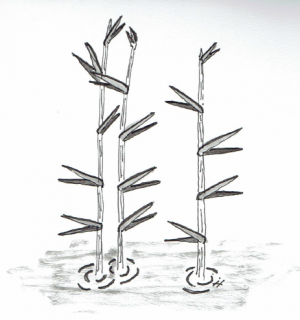Difference between revisions of "Beak Reed"
From World of Entorais Wiki
Jump to navigationJump to searchm (picture tags) |
m (→Description: grammar) |
||
| Line 3: | Line 3: | ||
;Common Names:Beak Reed | ;Common Names:Beak Reed | ||
;Classification:Herbaceous, Reed | ;Classification:Herbaceous, Reed | ||
This tall water reed is named for the appearance of its twined leaves | This tall water reed is named for the appearance of its twined leaves branching from the main stem. They form a structure resembling an open beak. The long stalks are used as a weaving material for a variety of goods, and are an excellent source of cordage fibres. Beak Reed is a useful febrifuge and antiemetic. The medicinal uses of this plant derive from the inner pulp of the root bulb near the base of the stalk. | ||
==Ecology== | ==Ecology== | ||
Revision as of 14:35, 24 December 2019
Description
- Common Names
- Beak Reed
- Classification
- Herbaceous, Reed
This tall water reed is named for the appearance of its twined leaves branching from the main stem. They form a structure resembling an open beak. The long stalks are used as a weaving material for a variety of goods, and are an excellent source of cordage fibres. Beak Reed is a useful febrifuge and antiemetic. The medicinal uses of this plant derive from the inner pulp of the root bulb near the base of the stalk.
Ecology
- Rarity
- Common
- Distribution
- Beak Reed is found throughout bogs, marshes, and coastal estuaries of Anexea at all latitudes.
- Life Cycle
Uses
- Cultivation
- wild
- Culinary
- none
- Medicinal
- febrifuge (root), antiemetic (root)
- Other
- weaving (stalks), cordage (stalks and leaves)
